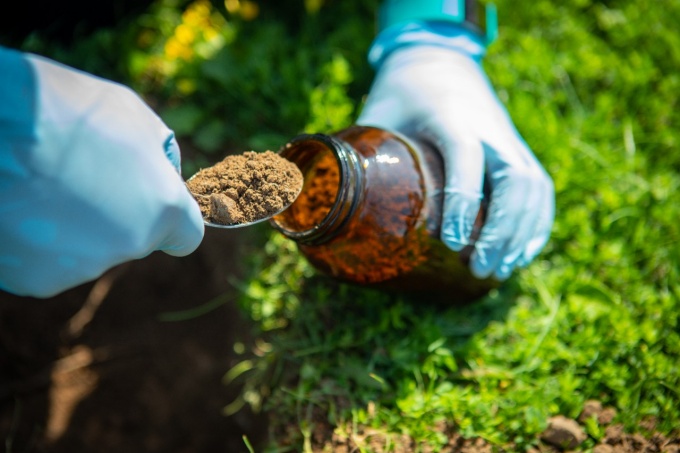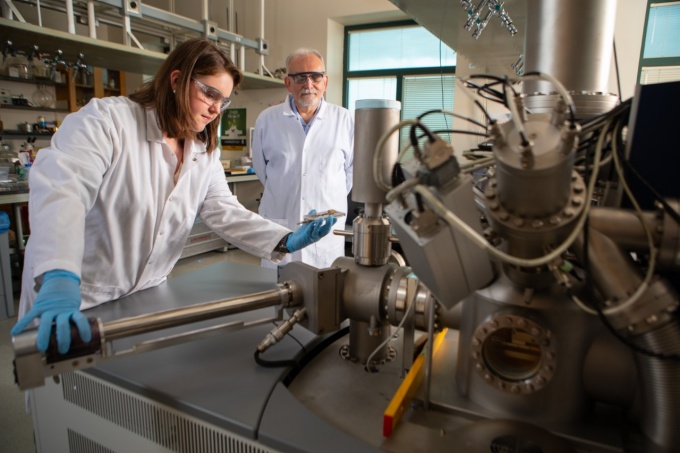Scientists share updates, including maps, from Tonawanda Coke Soil Study
A soil sample is taken in 2018. Credit: Douglas Levere / University at Buffalo
Researchers are working to complete an analysis of whether pollutants found in soil may have originated from Tonawanda Coke
Release Date: November 20, 2019
BUFFALO, N.Y. — On Nov. 21, scientists hosted a community meeting to update the public on the Tonawanda Coke Soil Study.
The purpose of the research, as ordered by a federal judge, is to investigate how pollution from the Tonawanda Coke plant may have impacted soil in nearby communities.
Key takeaways from the public meeting:
- Strong community involvement: The community has played a major role in the study since it began. Hundreds of local residents, as well as the Grand Island Central School District and Tonawanda City School District, have participated by having soil sampled from their properties. Many community members have attended public meetings organized by the study team, and about 25,000 flyers with information on the study were distributed door-to-door in neighborhoods. A community advisory committee met regularly during the study’s sampling phase, and committee members continue to be consulted as the research nears its conclusion.
- Maps modeling the estimated distribution of pollution complete: Scientists have completed maps modeling the estimated distributions of various pollutants at 6 inches below the surface of the ground. The maps, created using geographic modeling, are based on about 300 soil samples taken from homes, schools and other properties in 2017 and 2018.
It is important to note that soil contamination can vary significantly between properties and even within individual properties. As a result, homes, businesses and other properties located in contoured areas of the maps may have levels of contamination that are above or below the general estimated values indicated by the contours.
“The maps are useful because they guide us in understanding what region of the study area may have been impacted by pollution,” Joseph Gardella Jr., PhD, SUNY Distinguished Professor of Chemistry at the University at Buffalo, who is leading the study, said before the meeting. “If we have several soil samples in the same area with elevated levels of a pollutant, it creates a region on the map where there’s a higher probability of soil contamination. The maps are a way to better define the area where there may be a problem. In the past, we’ve seen too many examples of clean-ups that ended at property lines, when we know contamination can extend across property lines.
“The purpose of this study, in line with the judge’s order, is to understand the impact of the Tonawanda Coke plant’s emissions on soil. The maps highlight areas where some pollution was found, but we don’t know what fraction of that pollution is due to Tonawanda Coke, or the Huntley Plant or truck traffic or other things. We’re researching that problem now.”
- The study’s next steps focus on understanding whether pollutants may have originated at Tonawanda Coke: With the maps complete, scientists at UB and SUNY Fredonia are moving forward with a process called source apportionment. This involves using advanced analytical and statistical techniques to study whether certain pollutants found in the soil, such as polycyclic aromatic hydrocarbons (PAHs) and arsenic, may have come from the Tonawanda Coke plant.
“I lived in the shadow of Tonawanda Coke all my life, and I thought this was an important project that the community needs to be involved in,” says Anne Bazinet, a community advisory committee member and a resident of the Town of Tonawanda who had her soil sampled as part of the study. “It’s important to determine if any of the byproducts from Tonawanda Coke affected the community — if their particles landed on our yards, what they could have been, and what kind of potential clean-up there may need to be, if any.”
A fact sheet describing the study’s progress is available at http://www.buffalo.edu/news/releases/2019/11/021.html.
The fact sheet includes maps shared at the public meeting, which took place at Riverview Elementary School in the City of Tonawanda.
Joseph Gardella Jr., SUNY Distinguished Professor of Chemistry, who is leading the scientific analysis for the soil study, watches as a UB student (left) and Katie Little, former soil study commuity organizer, collect soil samples. Credit: Douglas Levere
The maps provide insight into geographic areas that may be impacted by pollution, but they do not highlight specific addresses where soil was sampled. The study team cannot publicly identify specific addresses because that data is protected by confidentiality agreements with property owners whose soil was tested. Scientists cannot violate the agreements. As such, the maps do not show individual data points, but instead have contours modeling the generalized, estimated distribution of pollutants in communities.
A federal judge ordered the Tonawanda Coke Corp. to fund the Tonawanda Coke Soil Study after the company was convicted of violating the Clean Air Act and Resource Conservation and Recovery Act.
Scientists working on source apportionment include Gardella; UB Research Assistant Professor of Chemistry Tammy Milillo, PhD; UB chemistry PhD candidate Kaitlin Ordiway; and SUNY Fredonia Professor of Chemistry Michael Milligan, PhD. All are experts in environmental chemistry.
Findings from the research will benefit residents in Grand Island, the City of Tonawanda, the Town of Tonawanda and North Buffalo by providing them with information about what chemicals are in their soil, how widespread any pollution may be, and whether these pollutants may have originated at the Tonawanda Coke plant.
University at Buffalo PhD candidate Kaitlin Ordiway (left) prepares to run a sample in a secondary ion mass spectrometer (SIMS). The SIMS can detect targeted compounds in chemical samples extracted from soil. UB chemistry professor Joseph Gardella (right) is leading the Tonawanda Coke Soil Study. Credit: Douglas Levere / University at Buffalo
Media Contact Information
Charlotte Hsu is a former staff writer in University Communications. To contact UB's media relations staff, email ub-news@buffalo.edu or visit our list of current university media contacts.





